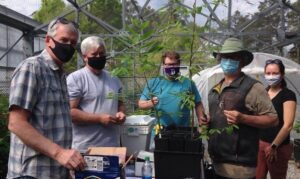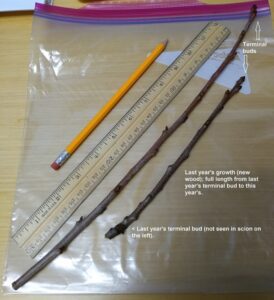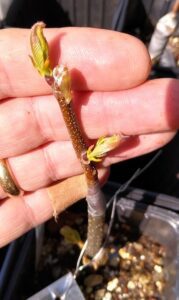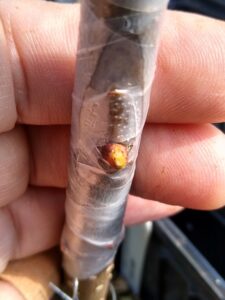On Wednesday, April 8, 2021, GA-TACF volunteers initiated a third year of grafting attempts as part of our American chestnut gene conservation program. This phase of the work took place at the Berry College nursery. Scion material was collected in Jan-March from 15 different American chestnuts by Ana Metaxas, Jack Rogers, Scott Laseter, David Keehn, and Martin Cipollini. Locations for these wild trees included Dade, Fannin, Harris, Lumpkin, Pike, Rabun, Union, Walker, and Whitfield Counties. The grafting was led by Hill Craddock (UTC), and assisted by John Hendrickson, Caitlin Conn, Paola Zannini, Tim Chesnut, and Martin Cipollini. In total, the group grafted 50 scions representing 15 different clones (3-4 scions per clone). Most grafts were done by Hill on Chinese chestnut rootstock using the bark-flap method. With luck, we hope that at least one scion from each clone will survive long enough to produce pollen for breeding purposes. With a good planting location (TBA), we hope that some may even live long enough to produce seeds. The ideal planting location will need to be a full-sun upland site with well-drained acidic soils.

Martin Cipollini, John Hendrickson, Tim Chesnut, Hill Craddock, and Caitlin Conn grafting chestnuts at Berry College. Photo by Paola Zannini.
This effort is directed toward rescuing trees from wild locations where they are either unable to flower or where the remoteness of the location is an impediment to hand-pollination or seed harvesting (which itself is extremely rare in GA). Pollen and/or offspring from grafted trees is intended to be used in future breeding efforts involving trees that carry either chestnut blight or Phytophthora root rot resistance (or both). In part, GA-TACF is making this effort to assist with the development of regional lines of trees for forest restoration purposes. Regardless of the means of obtaining disease resistance in American chestnut (e.g., backcross breeding, direct genetic modification), trees used for restoration purposes must be both genetically diverse and physiologically and ecologically suitable for the area in which the trees will be planted.

Hill Craddock demonstrating how to graft chestnuts with Tim Chesnut and John Hendrickson. Photo by Paola Zannini.
Pollen from several previously grafted trees was collected last summer, and will be used to hand-pollinate pure American chestnuts in a small orchard at Berry College as a means of obtaining seeds for the breeding program. In this manner, the genetic material can be amplified to numbers that can better ensure successful outcomes. Trees grown from seed also fare much better following planting than do pot-grafted trees. An alternative that we may consider for this year’s batch of grafted trees is to expose them to high-light treatments this winter as a means of encouraging early (precocious) flowering next year.
Many thanks to all who participated in this year’s efforts! We will keep you informed on the progress of the grafted trees. Upcoming volunteer activities for summer 2021 include hand-pollination work in early June and blight inoculation work in June/July. Look for announcements as volunteer work is being planned, and please consider helping out! Also, keep your calendars marked for GA-TACF’s May 22 membership meeting by internet conference. Details will be forthcoming shortly.
 Examples of dormant scion wood suitable for grafting purposes (in 1 gal bag). Photo by Martin Cipollini. |
 Grafted chestnuts (Chinese chestnut rootstock/American chestnut scions). Photo by Martin Cipollini. |
 Side flap graft of American chestnut on Chinese chestnut rootstock, 1 week post grafting. Photo by Martin Cipollini |
 Chip and bud graft of American chestnut on Chinese chestnut rootstock, 1 week post grafting. Photo by Martin Cipollini. |

